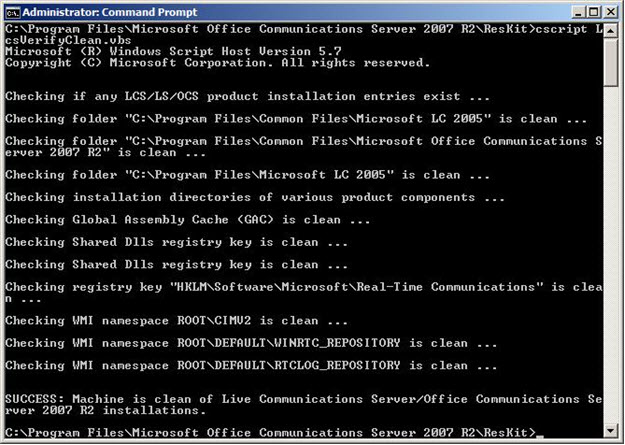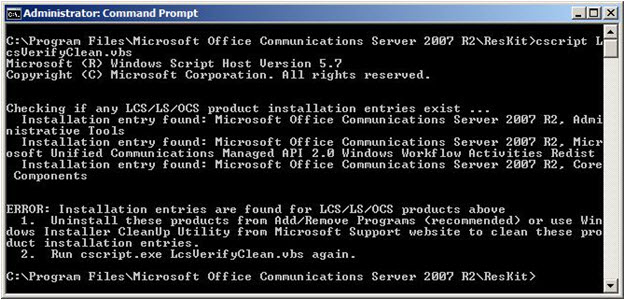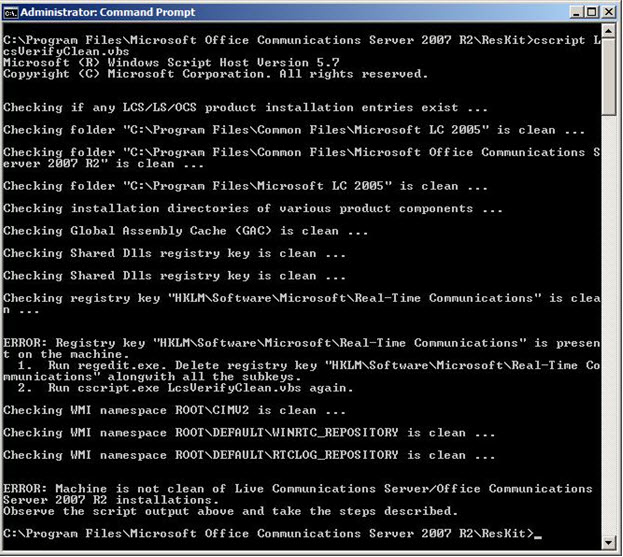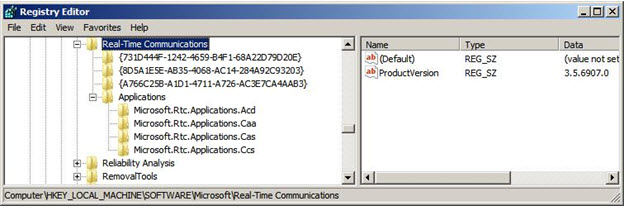Office Communications Server 2007 R2 Tool: LCS Verify Clean
The Microsoft Office Communications Server 2007 R2 LCS Verify Clean tool (LcsVerifyClean.vbs) is a command-line tool that can be used to troubleshoot issues during the uninstallation or installation of an Office Communications Server 2007 R2 deployment. LcsVerifyClean is an efficient and straightforward tool that provides step-by-step guidance through the sometimes stubborn uninstallation of Office Communications Server. You can download this tool and other Office Communications Server 2007 R2 Resource Kit tools from the Download Center.
Author: Mike Adkins
Publication date: July 2011
Product version: Office Communications Server 2007 R2
Introduction
LCS Verify Clean, a tool in the Office Communications Server 2007 R2 Resource Kit, is a straightforward command-line utility (LcsVerifyClean.vbs). LcsVerifyClean provides Office Communications Server administrators with diagnostic information that can be useful in detecting the cause of product installation failures that are sometimes caused by faulty Office Communications Server uninstallations. LcsVerifyClean provides Office Communications Server administrators with step-by-step guidance through the tricky process of removing Office Communications Server products. You can download this tool and other Office Communications Server 2007 R2 Resource Kit tools from the Download Center .
Description
The Office Communications Server set-up program checks for the remnants of prior installations of Office Communications Server. The set-up program may halt the installation process if legacy Office Communications Server information is detected locally on the computer that is running Windows Server. LcsVerifyClean verifies that your computer is clean of Office Communications Server product binaries, registry keys, and Windows Management Instrumentation (WMI) classes that may belong to a prior installation of Office Communications Server. LcsVerifyClean outputs the needed step-by-step uninstallation instructions to the Command Prompt window that it is run from. This process helps ensure the uninstallation of Office Communications Server from a computer running Windows Server.
Output
If LcsVerifyClean locates any legacy information, the tool provides the location of the unwanted information, and then prompts the administrator to remove it from the system before again running LcsVerifyClean from its Command Prompt window. For instance, when LcsVerifyClean locates Office Communications Server binaries that are installed on the computer running Windows Server, LcsVerifyClean will prompt the administrator to remove the preexisting binaries by using Add/Remove Programs in Control Panel in Windows Server 2003 or Program Features applets in Windows Server 2008 (see Figure 2). If LcsVerifyClean locates no legacy Office Communications Server information on the computer running Windows Server, the tool provides output as shown in Figure 1.
Figure 1. LcsVerifyClean shows the computer running Windows Server is clean of any legacy Office Communications Server information
Purpose
LcsVerifyClean has been available for use with both Office Communications Server 2007 R2 and Office Communications Server 2007. Each new release of LcsVerifyClean has been designed to check for the previous versions and the current version of Office Communications Server on the computer running Windows Server that hosts Office Communications Server. Using LcsVerifyClean as a preliminary step during the installation process of Office Communications Server helps ensure a trouble-free installation of Office Communication Server. Moreover, using LcsVerifyClean as the last step of the uninstallation process for an Office Communications Server uninstallation ensures that the computer running Windows Server that is to be re-purposed has no legacy Office Communications Server binaries, registry entries, or WMI information. The LcsVerifyClean uninstallation process begins with the manual uninstallation of any preexisting Office Communications Server binaries by using either of the following:
- Windows Server 2008: Program Features applets
- Windows Server 2003: Add/Remove Programs in Control Panel
After all preexisting Office Communications Server binaries have been removed, subsequent uses of LcsVerifyClean check for unwanted registry entries, installation folders, and WMI information. When the clean-up operation is complete, LcsVerifyClean will return information that is similar to Figure 1.
Requirements
The Office Communications Server 2007 R2 Resource Kit tools are supported on the following Window Server operating systems:
- Windows Server 2008 operating system
- Windows Server 2003 Standard Edition operating system with Service Pack 2 (SP2)
- Windows Server 2003 Enterprise Edition operating system with Service Pack 2 (SP2)
LcsVerifyClean requires the equivalent permissions from a member of the Domain Admins group in the Active Directory Domain Services domain that is hosting the Office Communications Server installation.
Examples
An Office Communications Server installation may be halted if the installation program detects any previously installed Office Communications Server information on the computer running Windows Server. LcsVerifyClean can determine the cause of the Office Communications Server installation failure (see Figure 2).
Figure 2. LCS Verify Clean displays the Office Communications Server binaries that need to be removed
Figure 2 recommends either of the following to remove the prior Office Communications Server installation application data from the system:
- Windows Server 2008: Program Features applets
- Windows Server 2003: Add/Remove Programs in Control Panel
Note The use of the Windows Installer Cleanup Utility in Figure 2 is no longer distributed or recommended by Microsoft. For details, see How do I uninstall Office 2003, Office 2007 or Office 2010 suites if I cannot uninstall it from Control Panel?
After the uninstallation of residual Office Communications Server applications from the computer that is running Windows Server, running LcsVerifyClean again displays legacy registry information that can halt the installation of Office Communications Server (see Figure 3).
Figure 3. LcsVerifyClean displays legacy registry information that needs to be removed
The error information in Figure 3 suggests removing legacy Office Communications Server registry information that is located at HKLM\Software\Microsoft\Real-Time Communications by using the registry editor tool on the computer running Windows Server (see Figure 4).
Warning: Before your delete any registry information, export (back up) this information as a .reg file to a safe location.
Figure 4. Use the Windows Server registry editor to remove the unwanted registry information
The legacy Office Communications Server uninstallation may now be complete. To confirm this, use the LcsVerifyClean tool one more time to ensure that its output matches the information in Figure 1.
Summary
Using the Office Communications Server 2007 R2 Resource Kit LCS Verify Clean tool to ensure the complete uninstallation of Office Communications Server from a computer running Windows Server is a sound preventive measure to take before re-purposing that server.
The challenge of a failed Office Communications Server installation can be met through the proper use of LcsVerifyClean to help ensure that residual Office Communications Server information is not preventing the installation. LcsVerifyClean has been updated and is reliable when used with either Office Communications Server 2007 R2 or Office Communications Server 2007.
Additional Information
For more information, see the following:
- Office Communications Server 2007 R2 Resource Kit Tools
- How do I uninstall Office 2003, Office 2007 or Office 2010 suites if I cannot uninstall it from Control Panel?
Lync Server Resources
- Lync Server 2010 documentation in the TechNet Library
- NextHop blog
- Lync Server and Communications Server resources
We Want to Hear from You
Keywords: WMI, removal, setup, failure, uninstallation



